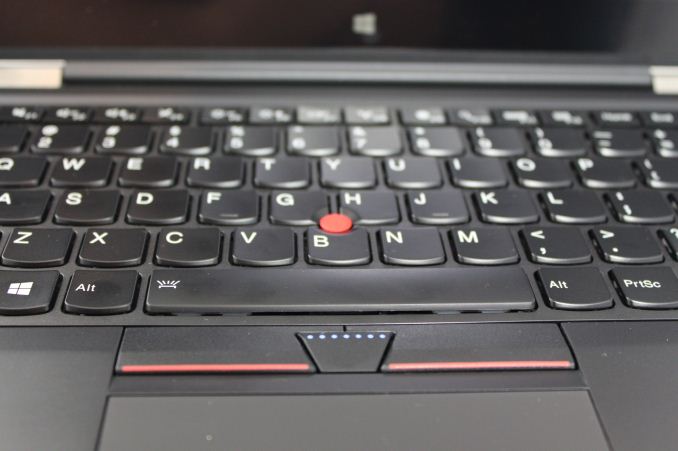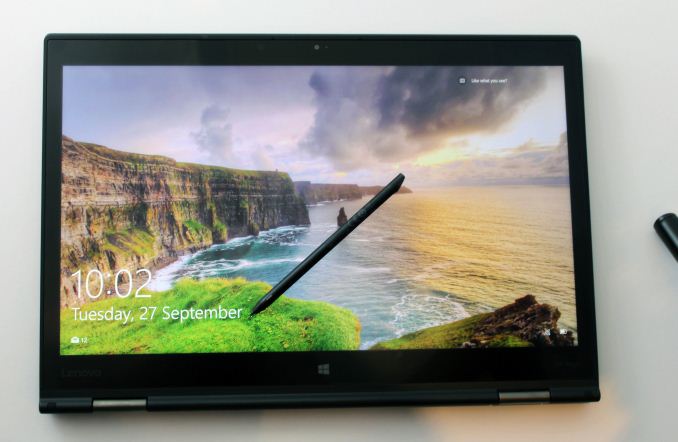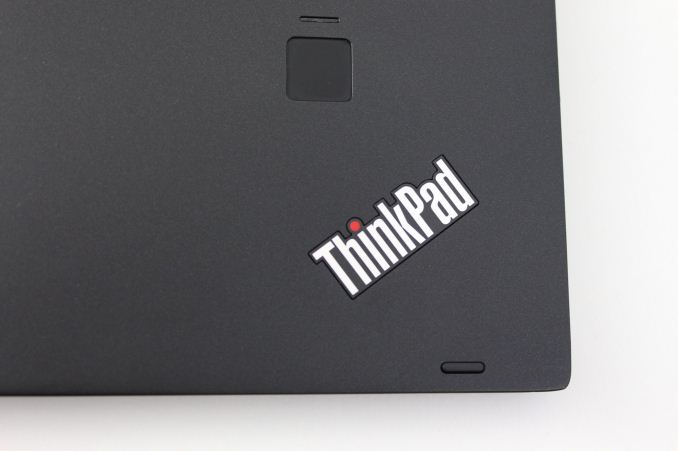The Lenovo ThinkPad X1 Yoga Review: OLED and LCD Tested
by Brett Howse & Brandon Chester on September 29, 2016 11:30 AM ESTFinal Words
Wrapping up, there’s quite a bit to go over with the ThinkPad X1 Yoga. Lenovo has done a great job continuing to make the X1 series thinner and lighter, and while some may question where that ends, anyone who needs a very portable laptop will appreciate this. Speaking of portability, Lenovo is one of the few brands to offer LTE connectivity in their ThinkPad lineup, further increasing the mobility of this notebook.
The X1 Yoga does a great job branching out from the X1 Carbon, which is itself an Ultrabook with positive characteristics. But the Yoga further builds on the Carbon by morphing that basic design into a thin and light two-in-one notebook using the Yoga hinge. For those looking for a notebook first, with some extra capabilities of being a touch device or tablet, the Yoga style devices from our experience win hands down over detachable convertibles. Compared to detachables, the Yoga devices have a much better weight distribution when used as a laptop, and Lenovo has included the ability to lock the keyboard when rotated, making it much better to hold and use in any of the non-laptop modes.
For performance, the battery life is reasonable by 2016 standards. One might suggest that with a premium line, a jump in platform efficiency would be a good aspect for the brand to move it into the higher echelons. Lenovo have been middle of the road against the competition in overall efficiency for some time - for some of the notebooks with large batteries this isn’t an issue, but on a size constrained notebook like the X1 Yoga, the effects are felt more quickly. The 52 Wh battery is a decent size for this size of notebook, but it isn't best-in-class.
We were lucky enough to be sampled both the LCD and OLED models to test. Lenovo is one of the first out of the gate with an OLED notebook, with a number of OLED designs on the market focusing on tablets, smartphones and VR. OLED technology has advantages that can really bring a wow factor to this market. The amazing contrast ratios of OLED easily outclass any LCD. While the OLED was advertised as highly accurate with specific options available, and it was much better than the LCD model, it still was not as good as some of the better notebooks we've seen over the past year or suited for professional use without user calibration tools. The color management software is comprehensive, so with some calibration the OLED on a per-unit basis from the factory would likely put the product ahead of the field in color accuracy.
It's hard to argue with the ThinkPad look, since it is so well known and Thinkpad customers demand it. Branding is difficult, and although some may find the ThinkPad lineup to be a bit low key, the matte black finish and design makes the laptop recognizable as a ThinkPad. Being a ThinkPad, it should be more durable than consumer notebooks, with a magnesium alloy chassis and military spec testing done to ensure it operates where many other laptops may struggle. For instance, the X1 Yoga, despite being convertible and despite having a lift and lock keyboard, still offers the spill-resistant keyboard. The polycarbonate exterior is pretty strong, especially where it is reinforced with carbon fibre, and there is a lot of durability there.
While the X1 Yoga keyboard can’t match some of the other thicker and heavier models like the T460s in key travel, it still has a great feel. The trackpad works well, and features a glass surface so it’s nice and smooth, which Lenovo combines with TrackPoint for those that use it.
Overall, the X1 Yoga is a good convertible. Lenovo has managed to make it thinner and lighter than the original X1 Carbon, yet still offer the versatility of the Yoga hinge. It's a solid offering from Lenovo. If thin, light, convertible, and business-class are all things you need, the X1 Yoga should be considered.













84 Comments
View All Comments
mooninite - Thursday, September 29, 2016 - link
$1800 and no Iris graphics? I'll pass.ddriver - Thursday, September 29, 2016 - link
Knock yourself out.JoeyJoJo123 - Thursday, September 29, 2016 - link
After you, ma'am.ddriver - Thursday, September 29, 2016 - link
U his boyfriend?The device scores in the top of its class as it is. Iris graphics won't make it more useful in its intended usage context, only more expensive. But I guess the important part here is that your boyfriend won't be buying a device cuz it didn't have a component that makes no sense having. Good to know.
JoeyJoJo123 - Thursday, September 29, 2016 - link
Another *simply epic* post by ddriver!forgot2yield28 - Friday, September 30, 2016 - link
You're joking, right? I run procurement for an architecture office. I wouldn't order this over an XPS 13 because you can get the XPS with Iris. They're not the workhorse of our office, but for getting some work done on an airplane and giving a presentation while manipulating CAD drawings, something with Iris or discrete graphics is critical. I can appreciate that the niche for professional ultrabook users who demand higher graphics performance is small, but to say that it wouldn't make the product more useful to professionals is simply shortsighted.close - Friday, September 30, 2016 - link
ddriver is usually here for two purposes:-some pseudo-engineering rants that are laughable until you realize he might actually believe them (then it feels like you're laughing at an autistic kid).
-make some sort of homophobic remark, or any kind of insult really. The kind that suggests he was raised and educated by 4chan.
ddriver - Friday, September 30, 2016 - link
I am glad you finally found a purpose in life. As pathetic as it may be, that's a huge step up for you LOL, your peak lifetime achievement really.ddriver - Friday, September 30, 2016 - link
You are joking, right? This is a convertible device that can be used as a tablet and comes with a stylus while the xps 13 is an ultrabook without tablet mode or stylus support. Which explains why the xps in a matching configuration is 100$ cheaper.If you are a professional and need to work with CAD you don't get a "business class" generic ultrabook, you get a laptop with dedicated professional graphics, or the very least, something with a decent discrete graphics, like the xps 15
Iris critical for CAD - that's laughable to say the least. But wait, since you did say "drawings" I can only assume you mean 2D in autocad, which, and I hate to break it to you, will show exactly ZERO advantage for iris over the plain integrated graphics. It will be marginally better for 3D, but nowhere near the 960m in the xps 15, which also has a bigger display at the same price point. Or maybe now you are also going to tell me that a smaller screen is also critical to working with cad and making presentations?
LordOfTheBoired - Friday, September 30, 2016 - link
*doesn't know CAD workload or terminology**is qualified to dictate CAD hardware demands*